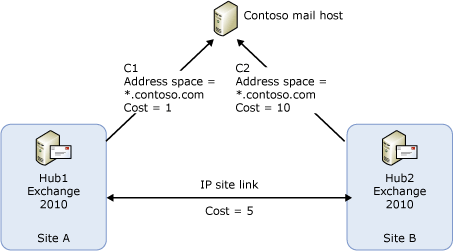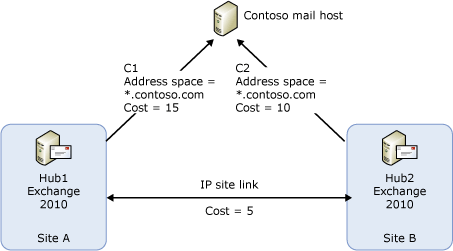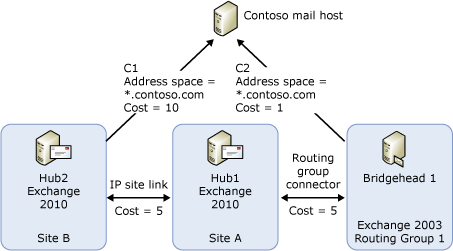Applies to: Exchange Server 2010 SP3, Exchange Server 2010 SP2
Topic Last Modified: 2009-12-07
Microsoft Exchange Server 2010 handles the routing of messages to external recipients. An external recipient is any message recipient that doesn't have a mailbox in the Exchange organization. Exchange uses Send connectors to route messages to external SMTP domains. If the external recipient isn't on an SMTP messaging system, a Delivery Agent connector or a Foreign connector is used instead.
For more information about how Exchange makes routing decisions, see Understanding Message Routing.
Looking for management tasks related to message routing? See Managing Message Routing.
Contents
Selecting the Routing Path to an External Recipient
Send Connectors
To route messages to external SMTP domains, you must configure at least one Send connector to relay messages to the Internet. You can configure a Send connector and define the address space as the asterisk (*) wildcard character. The * character indicates that the Send connector can be used to relay messages to all external SMTP addresses. You can also configure Send connectors to relay messages to specific address spaces when Send connector restrictions, such as message size, vary for those external domains.
When you configure a Send connector, you must select at least one source server for that Send connector. The source servers are the transport servers associated with that connector to handle message delivery. The source server for a Send connector can be a Hub Transport server, an Edge Transport server, or an Edge server subscribed to an Active Directory site. You can configure more than one source server for a Send connector to provide load balancing and fault tolerance for the address spaces defined on that Send connector. However, each Exchange 2010 source transport server you specify must be in the same Active Directory site.
For more information about how to configure your Exchange organization to send and receive Internet e-mail, see Managing Message Routing.
When Exchange is processing a message sent to an external recipient, the routing component of the Microsoft Exchange Transport service must select the best Send connector through which to route the message, and then calculate the least cost routing path to reach that Send connector.
To learn more about Send connectors, see Understanding Send Connectors.
Delivery Agent Connectors
Delivery Agent connectors are used to route messages addressed to messaging systems that don't use SMTP. When a message is routed to a Delivery Agent connector, the associated delivery agent performs the content conversion and message delivery. Delivery Agent connectors allow queue management for non-SMTP messages, thereby eliminating the need for storing messages on the file system in the Drop and Pickup directories. For more information, see Understanding Delivery Agents.
Foreign Connectors
Foreign connectors are used to send messages to third-party messaging systems. Each Foreign connector uses a Drop directory configured on the source Hub Transport servers for receiving messages. The foreign gateway server must be configured to obtain messages from the Drop directory specified for that Foreign connector. For more information about Foreign connectors, see Understanding Foreign Connectors.
Connector Considerations
Restrictions applied to the connectors may eliminate a specific connector from routing consideration. The following configuration options on connectors can determine whether those connectors are considered when making routing decisions. For more information about configuring connectors, see Managing Connectors.
Connector State
You can disable and enable any connector in your organization. If a connector is disabled, it's not considered when routing messages. For example, if an Exchange 2010 Send connector is disabled, messages aren't routed to that connector.
 Note: Note: |
|---|
| Exchange Server 2003 doesn't detect the disabled state of connectors. Therefore, if Exchange 2003 is deployed in the same organization, it may route to that connector. |
Connector Scope
Routing only considers connectors in scope for the sending server. By default, no scope limitation is applied to connectors, and they are available to all Hub Transport servers in the organization. However, you can specify a local scope for a connector. If you configure a connector as scoped, the availability of that connector is limited to Hub Transport servers located in the same Active Directory site as the source servers for the connector. Scoped connectors aren't considered when routing by Hub Transport servers in other Active Directory sites.
Address Space
The address space for a connector specifies the following:
- Recipient domains to which this connector routes e-mail
- Address space type
- Cost assigned to the address space for that connector
When you create a Send connector, the address space type is always configured as SMTP by default. Even though you can also specify a non-SMTP address space for a Send connector, the messages are still sent using SMTP. If you need to use a different transport protocol for transmitting messages to their destination, you must use a Delivery Agent connector or a Foreign connector.
When the Microsoft Exchange Transport service selects a connector for routing, it only considers connectors that have a matching address space for the destination domain. You can use the wildcard character * in an address space to indicate all domains, all domains that have a particular top-level domain, such as *.com, or a second-level domain and all its subdomains, such as *.contoso.com. When you configure a connector for a particular domain, e-mail sent to that domain is always routed through that connector.
If more than one connector matches the address space for the destination recipient domain, the connector with the more precise address match is selected. For example, if Send connector C1 is configured to have the address space *.contoso.com and Send connector C2 is configured to have the address space northamerica.contoso.com, e-mail addressed to user@europe.subdomain.contoso.com is routed to Send connector C1 and e-mail addressed to user@northamerica.contoso.com is routed to Send connector C2. Even though the latter address matches the address spaces on both connectors, the address space of C2 is a better match.
Message Size Restrictions
A message size restriction on a connector may also remove that connector from consideration during routing path selection if the message being routed is larger than the size restriction configured on that Send connector.
Cost
Connector cost is used to set selection priority when more than one connector is configured for the same address space. During routing, when the connector selection is made, the lowest cost routing path to the destination is selected. By adjusting connector costs, you can control the preferred routing path for mail flow in your organization and to the Internet. When you create a connector, the default cost is set to 1.
Selecting the Routing Path to an External Recipient
When a message is sent to an external recipient, Exchange 2010 will always select a single connector through which to send the message. The selected connector must meet the message size constraints. After Exchange 2010 has eliminated all connectors whose message size restrictions are less than the size of the message being routed, routing applies the following criteria to determine which connector it will select:
- From the list of all the connectors configured in the Exchange
organization, Exchange narrows the list to connectors that satisfy
all the following criteria:
- In the scope for the local server
- Enabled
- With an address space that matches the recipient's e-mail
domain
- In the scope for the local server
- From the resulting list, Exchange selects the connector with
the most specific address space match.
If more than one connector meets the address space match criteria, Exchange 2010 routing evaluates the following criteria to select a connector:
- Connector cost The cost of the
connector is the sum of the cost assigned to all the IP site links
between the source Active Directory site and the Active Directory
site that contains the source servers for the connector, and the
cost assigned to the connector. The connector with the lowest
aggregate cost is selected. If more than one connector has the same
cost, the selection process continues to the next step.
- Proximity The source server that has
the closest proximity to the routing server is selected. This means
that the local server is chosen over another Hub Transport server
in the same Active Directory site, and a server in the local Active
Directory site is chosen over a source server in a remote Active
Directory site. If more than one connector matches the criteria,
the selection process continues to the next step.
- Alphanumerically lower connector
name If more than one routing path has the
same cost and proximity, the connector with the name that has the
lowest alphanumeric value is selected.
Routing Path Selection When Coexisting with Exchange 2003
In a coexistence scenario, the selection varies slightly depending on whether the source server for the selected connector is an Exchange 2010 or Exchange 2003 server.
If more than one connector meets the address space match criteria, and they are all are hosted on servers running Exchange 2003, the following selection method is used:
- Connector cost The cost of the
connector is the sum of the cost assigned to all the routing group
connectors between the routing server and the routing group that
contains the source servers for the connector and the cost assigned
to the connector.
- Alphanumerically lower connector
name If more than one routing path has the
same cost and proximity, the connector with the name that has the
lowest alphanumeric value is selected.
If more than one connector meets the address space match criteria, and they are spread across Exchange 2010 and Exchange 2003, Exchange 2010 will always prefer Exchange 2010 connectors.
When a connector is selected, if there are legacy servers listed as source servers as well as Exchange 2010 servers, messages are routed to the Exchange 2010 servers. When all things are equal, Exchange 2010 will always route the messages to other Exchange 2010 servers.
After a connector is selected by using the previous criteria, there may be more than one routing path to reach the Active Directory site where the source server for the selected connector is located. In this case, the lowest cost routing path to the connector is calculated by using the logic used for intra-organizational routing. For more information, see Internal Message Routing.
Handling Messages That Can't Be Routed
If no connector satisfies all criteria required to select a connector according to the logic described earlier, one of the following actions occurs:
- If there is no matching connector for an SMTP address space,
the recipient is marked as unreachable and the message is routed to
the Unreachable queue.
- If the message size exceeds the connector size restriction for
all connectors, a non-delivery report (NDR) is returned to the
sender.
- If there is no matching connector for a non-SMTP address space,
an NDR is returned to the sender.
Routing Examples
The following examples illustrate how messages are routed to external recipients.
Example 1: Selecting a Connector Based on Address Space Match
In this topology, a message is being routed from Active Directory Site A to the external recipient, john@subdomain.contoso.com. The following figure shows that two connectors can route messages to this address space.

The following table shows the configuration of two Send connectors in an Exchange 2010 topology.
Examples of Send connector configurations
| Send connector name | Address space | Connector cost | Source servers | Message size restrictions |
|---|---|---|---|---|
|
C1 |
*.contoso.com |
1 |
Hub Transport servers in Active Directory Site A |
None |
|
C2 |
subdomain.contoso.com |
10 |
Hub Transport servers in Active Directory Site B |
None |
In this scenario, the message is routed by using C2 because the most specific address space match is chosen. C1 has a lower routing cost, and the source servers are located in the same site as the Hub Transport server processing the message. However, the address space match takes priority over the other factors.
Example 2: Selecting a Connector Based on Proximity
In this scenario, a message is being routed by a Hub Transport server located in Active Directory Site A to the external recipient, john@subdomain.contoso.com, as shown in the following figure.

The following assumptions apply:
- The routing server isn't listed as a source server for any Send
connector.
- The IP site link between Site A and Site B is assigned a cost
of 5.
- Two Send connectors can route messages to the address space.
The following table shows the connector configuration.
Alternative Send connector configuration
| Send connector name | Address space | Address space cost | Source servers | Message size restrictions |
|---|---|---|---|---|
|
C1 |
subdomain.contoso.com |
15 |
Hub Transport servers in Active Directory Site A |
None |
|
C2 |
subdomain.contoso.com |
10 |
Hub Transport servers in Active Directory Site B |
None |
Because both connectors have the same address space match, the connector cost is evaluated next. The cost assigned to connector C2 is added to the cost of the IP site link between Active Directory Site A and Site B, for a combined cost of 15. The source servers for connector C1 are located in the local Active Directory site. Therefore, the IP site link cost to reach the connector is 0, for a total cost of 15. In this scenario, both connectors match the address space equally and have an equal cost. Routing selects connector C1 because it has a closer proximity.
Example 3: Selecting a Connector Based on Exchange Version
In the next example, a message is being relayed from Active Directory Site A to the external recipient, john@contoso.com, as shown in the following figure.

The following assumptions apply:
- There are two Send connectors that match the destination
address space equally.
- The source servers for the routing group connector between
Exchange 2003 and Exchange 2010 are located in Site A.
- The routing group connector has a routing cost of 5.
- The IP site link between Site A and Site B is assigned a cost
of 5.
- The source server for one of the Send connectors is an Exchange
2003 server located in routing group 1. The following table shows
the connector configuration.
Connectors configured on different versions of Exchange
| Connector name | Address space | Address space cost | Source servers | Message size restrictions |
|---|---|---|---|---|
|
C1 |
*.contoso.com |
10 |
Hub Transport servers in Active Directory Site B |
None |
|
C2 |
*.contoso.com |
1 |
Exchange 2003 bridgehead servers in routing group 1 |
None |
In this scenario, the aggregate cost of using connector C1 is 15, which is the sum of the IP site link cost and the Send connector cost. The aggregate cost of using connector C2 is 6, which is the sum of the routing group connector cost and the Send connector cost. However, even though C1 has a lower routing cost, Exchange will still route the message to the Exchange 2010 connector.

